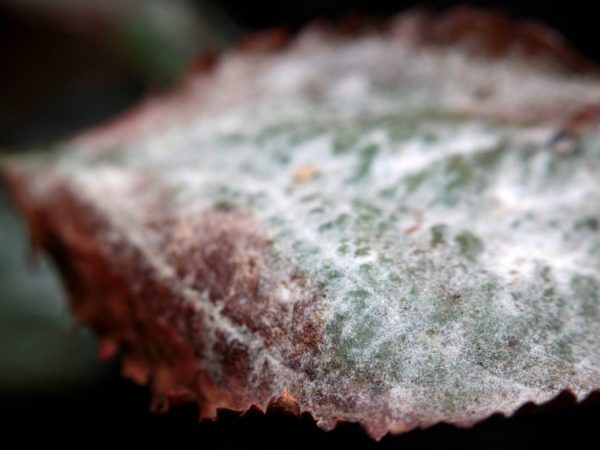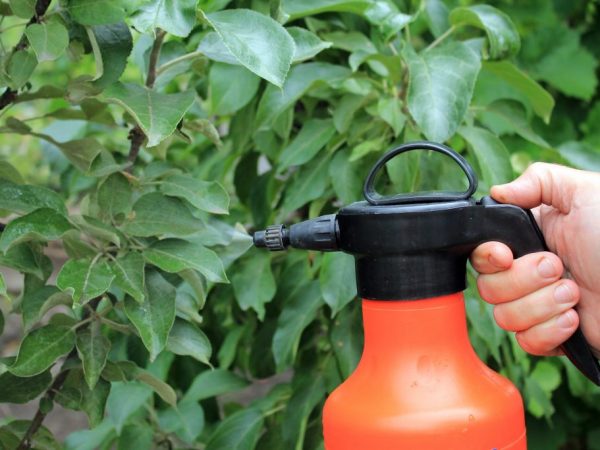Causes and treatment of white bloom on apple leaves
Powdery mildew or white bloom on the leaves of an apple tree appears for various reasons and can lead not only to the loss of a large amount of the crop, but also to the death of the tree. Basically, the disease is caused by a fungal infection.

Causes and treatment of white bloom on apple leaves
Causes of the disease
The causative agent of the disease is the fungus Erysiphales. It is spread by the wind, birds and various insects, penetrates the vegetative buds of the plant and begins to parasitize on all organs - buds, leaves, shoots, trunk.
Infection occurs very quickly. The spores of the fungus penetrate deep into the tissues, sucking the juice from the green parts.
Matured fungal spores can successfully overwinter on infected foliage, only when the temperature drops to -27 ° they die.
The peak of tree infection occurs at the beginning of summer - it is during this period that the fruiting body of the fungus is released.
A white bloom on an apple tree appears for the following reasons:
- hot weather with sharp temperature changes and high air humidity (fog, dew, heat);
- trees overfed with nitrogen can become infected with powdery mildew;
- old specimens that have undergone a radical rejuvenating pruning are often susceptible to this sore;
- growing in a weed and overgrown garden (where the ideal environment for the development of pathogenic microflora).
Signs of tree damage
- First, the leaves are covered with a whitish bloom, resembling flour.
- Over time, the plaque thickens and takes on a brownish tint. The affected organs stop their growth, begin to curl and crumble.
- Shoots damaged by powdery mildew, first turn white, then turn brown, and at an advanced stage they completely die off.
- The flowers are covered with a whitish bloom of a thick consistency, which is why they bloom in a chaotic manner, deform and dry out. Fruit ovaries do not have time to develop from such buds.
- A grayish bloom and deep cracks appear on the peel of apples.
Development cycle
Fungal spores can be spread not only by the wind, but also by droplets of water, as well as by contact of sick apple trees with healthy ones.
Powdery mildew that appears on one apple tree negatively affects the development of the entire garden. Trees begin to shed green foliage intensively, reducing the amount of harvest.
This sore has two stages of development:
- marsupial;
- conidial.

The disease is spreading rapidly
A sign of sporulation of conidia is a whitish bloom on different parts of the tree. The first stage of the development of the disease occurs in early spring, when the vegetative buds begin to swell. Infection occurs through infected ovaries.
Conidia are the source of secondary infection.
The first stage of the disease lasts for about a month. After this comes the second (in the last decade of May or in the first decade of June) - the marsupial.During this period, black fruiting bodies appear on the foliage and shoots, which cause the death and drying of the affected organs.
Powdery Mildew Resistant Varieties
When planting, apple varieties resistant to fungal infection should be used:
- Florin;
- Arbat;
- Gold Rush;
- Bridgum Delicious.
By using these hybrid forms when planting, you can save up to 80% of the yield and grow strong and healthy trees.
Control methods
In spring and autumn, prophylactic pruning of trees is carried out - all shoots damaged by diseases, parasites, winds and frosts are cut out. The cut parts are subject to incineration, because they are the source of infection.
Chemical treatment
In the fight against white bloom, fungicides are used:
- Hom or copper oxychloride. The blue powder is dissolved in warm water according to the instructions. Processing is carried out in calm weather at a temperature not exceeding 30 °.
- Tebuconazole. A systemic fungicide is able to penetrate deeply into plant tissues, neutralize the effect of fungal infection and create protection for three weeks after treatment. This remedy is quite effective in the advanced stage of the lesion. He has two analogues - Flutriafol and Penconazole.
- Fitosporin. Biological preparation, which includes living cells and fatty spores. Processing the crown with this tool can be carried out in any weather. If rainy weather is foreseen, then the processing is carried out a couple of hours before the start of the rain and two hours after it.
- Colloidal sulfur (cumulus). Granular, inorganic fungicide, the maximum effectiveness of which is manifested in cool weather - the optimum air temperature for processing is 25-27 °.
- Urea. Nitrogen-containing top dressing, which is carried out at the beginning of the growing season. Dissolve 200 g of the substance in a bucket of water.
- Impact. Low-toxic, antifungal fungicide, which is used in early spring or late autumn. Creates effective protection against powdery mildew for 30 days.
- Speed A systemic fungicide used for both therapeutic and prophylactic purposes. The effect of the drug occurs two hours after treatment. Spraying can be carried out in any weather. For the entire season, plants must be treated at least four times with an interval of 20 days.
- Topaz. A systemic fungicide, it helps well in the early stages of the lesion. The number of treatments is four, the interval is three weeks.
Folk remedies

Treatment will help cope with the disease
From folk recipes in the fight against powdery mildew on an apple tree, it helps well:
- Garlic infusion. To prepare it, you will need 4 peeled and chopped heads of garlic in a bucket of water. Insist 5 hours, spray the crown and soil in the near-stem zone with a working solution.
- Useful vegetation - pyrethrum, mustard, vetch, green peas, marigolds. They are not only planted on the site, but also used to prepare green infusions. 2 liters of chopped grass are poured with 5 liters of water, insisted for a day, then filtered and sprayed.
- Mix the milk solution (1 l) with water (10 l). Lactic acid bacteria adversely affect the vital activity of the fungus, leading to its death.
- Ash solution (4 kg of ash are consumed per 10 liters of water). They insist for a day, then the crown and the near-stem zone are sprayed with a working solution twice with an interval of 10 days.
- Soap solution. In 10 liters of water, dissolve 100 g of crushed laundry soap. Add 2 tbsp to the solution. l. baking soda, stir well and process the crown at least three times at intervals of 10 days.
Prophylaxis
In addition to choosing high-quality planting material that is resistant to powdery mildew, gardeners take a number of preventive measures to prevent the appearance of a fungal infection:
- avoid thickening of plantings and crowns;
- observe the optimal moisture levels in the garden;
- timely trimming and disposal of organs damaged by the disease;
- keep the site clean - remove weeds, carrion and fallen leaves;
- carry out an annual autumn digging of the site;
- I treat trees in early spring and late autumn with fungicides - Bordeaux mixture and copper sulfate.
Common mistakes gardeners make
Out of inexperience, many gardeners make mistakes in the care and maintenance of an apple orchard, which leads to infection with powdery mildew:
- overfeeding trees with nitrogenous preparations;
- lack of annual spring and autumn pruning;
- use of varieties weakly resistant to fungal infection when planting;
- non-compliance with dosages and intervals between treatments;
- untimely removal of weeds, carrion and fallen leaves, which are a source of infection;
- lack of regular watering, top dressing.

